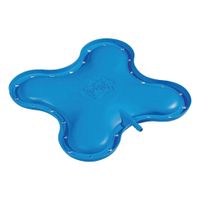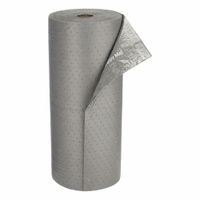Call +(254) 703 030 000 / 751 483 999 / 721 704 777
- Home
- Safety
- Sorbents Spill Control Spill Containment
- Sorbents Spill Kits
- Biohazardous Liquid Bodily Fluid Sorbents Spill Kits
.....Read More
Frequently Asked Questions
What are biohazardous liquid and bodily fluid sorbents used for?
Biohazardous liquid and bodily fluid sorbents are specialized materials used to manage and contain hazardous biological spills, such as blood, urine, vomit, and other bodily fluids, in a safe and efficient manner. These sorbents are crucial in healthcare settings, laboratories, and any environment where there is a risk of exposure to infectious materials. Their primary purpose is to absorb and contain potentially infectious fluids to prevent the spread of pathogens and protect individuals from exposure.
These sorbents are designed to quickly absorb large volumes of liquid, transforming them into a solid or gel-like state, which makes cleanup easier and reduces the risk of contamination. They often contain antimicrobial agents to neutralize pathogens, further enhancing safety. The materials used in these sorbents are typically non-toxic and designed to be disposed of safely, adhering to regulatory guidelines for biohazardous waste.
In addition to healthcare facilities, biohazardous liquid and bodily fluid sorbents are used in emergency response situations, such as accidents or crime scenes, where there is a need to manage biological spills quickly. They are also employed in industrial settings where workers might be exposed to biohazardous materials.
Overall, these sorbents play a critical role in infection control, ensuring that biohazardous spills are managed effectively to protect public health and safety.
How do biohazardous liquid and bodily fluid spill kits work?
Biohazardous liquid and bodily fluid spill kits are designed to safely clean and decontaminate areas affected by potentially infectious materials. These kits typically include personal protective equipment (PPE) such as gloves, masks, and gowns to protect the user from exposure. They also contain absorbent materials like pads or granules to soak up the spill efficiently.
The process begins with donning the PPE to ensure safety. The absorbent materials are then applied to the spill to contain and solidify the liquid, making it easier to handle. Some kits include a solidifier that turns liquids into a gel-like substance, preventing further spread and facilitating removal.
Once the spill is absorbed, the contaminated materials are collected using tools like scoops or scrapers, which are often included in the kit. These materials are then placed in biohazard bags for safe disposal, adhering to local regulations for hazardous waste.
The area is then cleaned and disinfected using the provided cleaning agents, which are typically hospital-grade disinfectants effective against a wide range of pathogens. This step ensures that any remaining microorganisms are eliminated, reducing the risk of infection.
Finally, all used PPE and cleaning materials are disposed of in the biohazard bags, and hands are thoroughly washed to complete the decontamination process. These kits are essential in healthcare settings, laboratories, and any environment where exposure to biohazardous materials is possible, ensuring safety and compliance with health standards.
What materials are included in a biohazardous spill kit?
A biohazardous spill kit typically includes the following materials:
1. **Personal Protective Equipment (PPE):**
- Gloves (nitrile or latex)
- Gowns or aprons
- Face masks or respirators
- Safety goggles or face shields
- Shoe covers or booties
2. **Absorbent Materials:**
- Absorbent pads or pillows
- Absorbent granules or powders
3. **Cleaning and Disinfecting Agents:**
- Disinfectant wipes
- Spray bottles with disinfectant solution (e.g., bleach solution or other EPA-approved disinfectants)
4. **Containment and Disposal Supplies:**
- Biohazard bags (red or yellow)
- Sharps containers for needles or other sharp objects
- Tongs or forceps for picking up contaminated items
- Dustpan and brush or scraper for solid waste
5. **Spill Control Items:**
- Spill containment booms or socks
- Plastic sheeting or barriers
6. **Instructional Materials:**
- Spill response procedure guide
- Emergency contact information
7. **Miscellaneous:**
- Labels for biohazard waste
- Hand sanitizer
- Paper towels or cloths
These materials are designed to ensure safe and effective cleanup of biohazardous spills, protecting both the responder and the environment from potential contamination.
How do you properly dispose of biohazardous sorbents after use?
To properly dispose of biohazardous sorbents after use, follow these steps:
1. **Identification**: Ensure the sorbents are classified as biohazardous waste. This includes materials contaminated with blood, bodily fluids, or other potentially infectious substances.
2. **Personal Protective Equipment (PPE)**: Wear appropriate PPE such as gloves, gowns, masks, and eye protection to prevent exposure during handling.
3. **Containment**: Place the used sorbents in a designated biohazard bag. These bags are typically red or marked with the biohazard symbol. Ensure the bag is leak-proof and puncture-resistant.
4. **Sealing**: Securely seal the biohazard bag. Use tape or a twist tie to ensure it is tightly closed to prevent leakage or exposure.
5. **Labeling**: Clearly label the bag with the biohazard symbol and any other required information, such as the date and type of waste.
6. **Storage**: Store the sealed biohazard bags in a designated biohazard waste container. This container should be rigid, leak-proof, and labeled with the biohazard symbol.
7. **Transportation**: Arrange for the transportation of the biohazard waste by a licensed medical waste disposal service. Ensure compliance with local, state, and federal regulations regarding the transport of biohazardous materials.
8. **Documentation**: Maintain records of the disposal process, including the type and amount of waste, date of disposal, and the disposal service used.
9. **Training**: Ensure all personnel involved in the disposal process are trained in handling biohazardous waste and understand the relevant regulations and procedures.
10. **Compliance**: Follow all applicable regulations and guidelines from agencies such as OSHA, EPA, and local health departments to ensure safe and legal disposal.
By adhering to these steps, you can ensure the safe and compliant disposal of biohazardous sorbents.
What is the difference between sorbent pads and granular sorbents?
Sorbent pads and granular sorbents are both used for absorbing liquids, but they differ in form, application, and efficiency.
Sorbent Pads:
- **Form**: Sorbent pads are flat, sheet-like materials, often made from polypropylene or other synthetic fibers.
- **Application**: They are ideal for surface spills, especially on flat surfaces. Pads are easy to deploy and retrieve, making them suitable for quick response to spills.
- **Efficiency**: Pads are designed to absorb specific types of liquids, such as oil-only, universal (oil and water), or chemical-specific. They offer high absorption capacity and are effective for containing and cleaning up spills.
- **Advantages**: Easy to handle, dispose of, and store. They provide a clean and efficient way to manage spills without scattering material.
- **Limitations**: Less effective for spills in hard-to-reach areas or uneven surfaces.
Granular Sorbents:
- **Form**: Granular sorbents are loose, particulate materials, often made from clay, silica, or recycled materials.
- **Application**: Suitable for uneven surfaces, they can be spread over spills to absorb liquids. Granular sorbents are versatile and can be used in various environments, including industrial settings.
- **Efficiency**: They can absorb a wide range of liquids, including oils, chemicals, and water. However, they may require more material to achieve the same absorption as pads.
- **Advantages**: Effective for large spills and can be used in areas where pads are impractical. They provide traction on slippery surfaces.
- **Limitations**: Can be messy, difficult to clean up, and may generate dust. Disposal can be more challenging compared to pads.
In summary, the choice between sorbent pads and granular sorbents depends on the spill type, location, and cleanup requirements.
How do you choose the right spill kit for a specific biohazardous liquid?
1. **Identify the Biohazardous Liquid**: Determine the type of biohazardous liquid involved, such as blood, bodily fluids, or infectious agents. Understanding the specific risks and properties of the liquid is crucial.
2. **Assess the Volume**: Estimate the potential volume of the spill. This will help in selecting a spill kit with adequate absorbent capacity to handle the spill effectively.
3. **Consider the Environment**: Evaluate the location where the spill might occur. Consider factors like ventilation, surface type, and proximity to sensitive areas or equipment.
4. **Check Regulatory Requirements**: Ensure compliance with relevant health and safety regulations, such as OSHA or CDC guidelines, which may dictate specific requirements for handling biohazardous spills.
5. **Select Appropriate Absorbents**: Choose a spill kit with absorbents specifically designed for biohazardous materials. These absorbents should be capable of safely containing and neutralizing the specific liquid.
6. **Personal Protective Equipment (PPE)**: Ensure the spill kit includes appropriate PPE, such as gloves, masks, gowns, and eye protection, to protect responders from exposure.
7. **Disposal Materials**: The kit should contain biohazard bags and containers for safe disposal of contaminated materials, in accordance with biohazard waste disposal regulations.
8. **Decontamination Supplies**: Look for kits that include disinfectants or decontamination agents effective against the specific pathogens present in the biohazardous liquid.
9. **Training and Instructions**: Ensure the spill kit comes with clear instructions and that personnel are trained in its use. Proper training is essential for effective and safe spill response.
10. **Review and Update**: Regularly review and update spill kits to ensure they remain effective and compliant with any changes in regulations or operational needs.
Are there regulations for handling and disposing of biohazardous liquid spills?
Yes, there are regulations for handling and disposing of biohazardous liquid spills. These regulations are designed to protect public health and the environment from potential hazards associated with biohazardous materials. Key regulations and guidelines include:
1. **OSHA Bloodborne Pathogens Standard (29 CFR 1910.1030):** This U.S. regulation mandates that employers protect workers from health hazards caused by bloodborne pathogens. It requires the implementation of an Exposure Control Plan, use of personal protective equipment (PPE), and proper training for handling biohazardous materials.
2. **EPA Regulations:** The Environmental Protection Agency (EPA) oversees the disposal of hazardous waste, including biohazardous liquids, under the Resource Conservation and Recovery Act (RCRA). Facilities must follow specific procedures for waste classification, storage, and disposal.
3. **CDC Guidelines:** The Centers for Disease Control and Prevention (CDC) provides guidelines for the safe handling of biohazardous materials, including spill response procedures. These guidelines emphasize containment, decontamination, and proper disposal.
4. **State and Local Regulations:** Many states and localities have additional regulations that govern the handling and disposal of biohazardous materials. These may include specific licensing requirements for waste transporters and disposal facilities.
5. **Institutional Policies:** Hospitals, laboratories, and research institutions often have their own protocols for managing biohazardous spills, which align with federal and state regulations. These protocols typically include immediate containment, notification of appropriate personnel, and detailed cleanup procedures.
Overall, compliance with these regulations is crucial to ensure safety and prevent environmental contamination. Facilities handling biohazardous materials must stay informed about applicable laws and regularly train employees on proper spill response and disposal techniques.



